2006 FORD RANGER jump start
[x] Cancel search: jump startPage 2 of 256

Seating and Safety Restraints 64
Seating 64
Safety restraints 67
Airbags 78
Child restraints 88
Tires, Wheels and Loading 101
Tire Information 103
Tire Inflation 105
Vehicle loading 117
Trailer towing 124
Recreational towing 133
Driving 135
Starting 135
Brakes 139
Transmission operation 142
Roadside Emergencies 157
Getting roadside assistance 157
Hazard flasher switch 159
Fuel pump shut-off switch 159
Fuses and relays 160
Changing tires 170
Lug Nut Torque 178
Jump starting 178
Wrecker towing 184
Customer Assistance 185
Reporting safety defects (U.S. only) 191
Cleaning 192
Table of Contents
2
2006 Ranger(ran)
Owners Guide (post-2002-fmt)
USA(fus)
Page 157 of 256
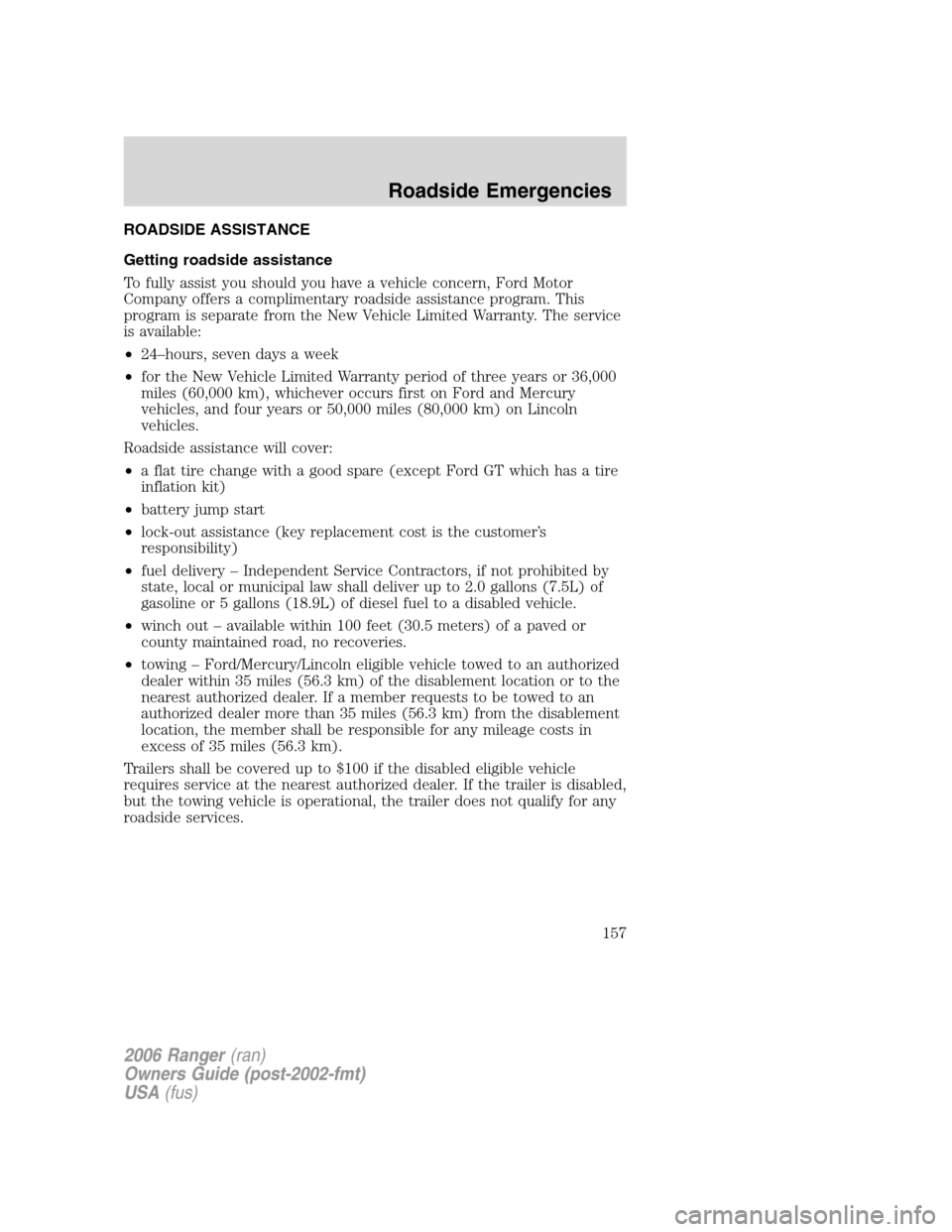
ROADSIDE ASSISTANCE
Getting roadside assistance
To fully assist you should you have a vehicle concern, Ford Motor
Company offers a complimentary roadside assistance program. This
program is separate from the New Vehicle Limited Warranty. The service
is available:
•24–hours, seven days a week
•for the New Vehicle Limited Warranty period of three years or 36,000
miles (60,000 km), whichever occurs first on Ford and Mercury
vehicles, and four years or 50,000 miles (80,000 km) on Lincoln
vehicles.
Roadside assistance will cover:
•a flat tire change with a good spare (except Ford GT which has a tire
inflation kit)
•battery jump start
•lock-out assistance (key replacement cost is the customer’s
responsibility)
•fuel delivery – Independent Service Contractors, if not prohibited by
state, local or municipal law shall deliver up to 2.0 gallons (7.5L) of
gasoline or 5 gallons (18.9L) of diesel fuel to a disabled vehicle.
•winch out – available within 100 feet (30.5 meters) of a paved or
county maintained road, no recoveries.
•towing – Ford/Mercury/Lincoln eligible vehicle towed to an authorized
dealer within 35 miles (56.3 km) of the disablement location or to the
nearest authorized dealer. If a member requests to be towed to an
authorized dealer more than 35 miles (56.3 km) from the disablement
location, the member shall be responsible for any mileage costs in
excess of 35 miles (56.3 km).
Trailers shall be covered up to $100 if the disabled eligible vehicle
requires service at the nearest authorized dealer. If the trailer is disabled,
but the towing vehicle is operational, the trailer does not qualify for any
roadside services.
2006 Ranger(ran)
Owners Guide (post-2002-fmt)
USA(fus)
Roadside Emergencies
157
Page 178 of 256
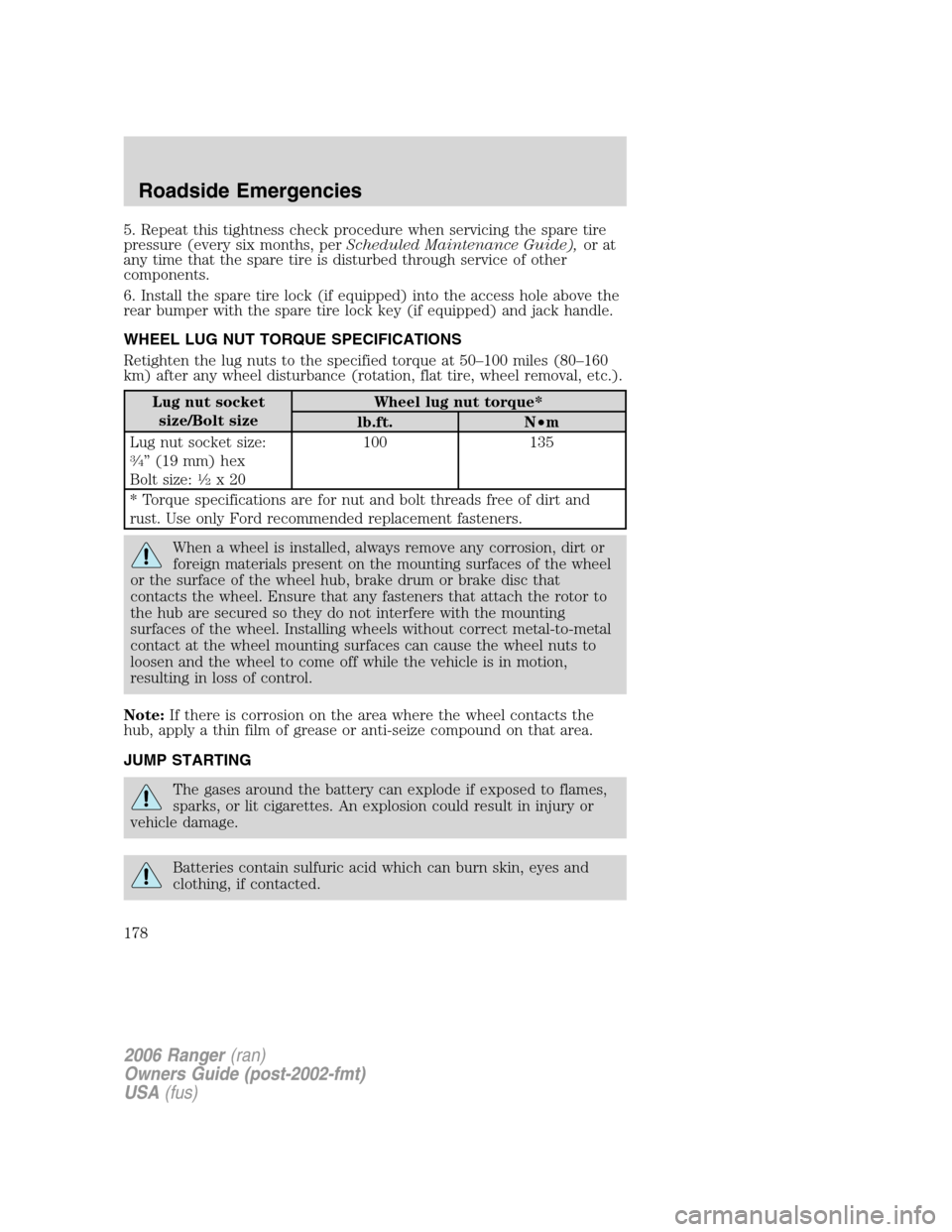
5. Repeat this tightness check procedure when servicing the spare tire
pressure (every six months, perScheduled Maintenance Guide),or at
any time that the spare tire is disturbed through service of other
components.
6. Install the spare tire lock (if equipped) into the access hole above the
rear bumper with the spare tire lock key (if equipped) and jack handle.
WHEEL LUG NUT TORQUE SPECIFICATIONS
Retighten the lug nuts to the specified torque at 50–100 miles (80–160
km) after any wheel disturbance (rotation, flat tire, wheel removal, etc.).
Lug nut socket
size/Bolt sizeWheel lug nut torque*
lb.ft. N•m
Lug nut socket size:
3�4” (19 mm) hex
Bolt size:1�2x20100 135
* Torque specifications are for nut and bolt threads free of dirt and
rust. Use only Ford recommended replacement fasteners.
When a wheel is installed, always remove any corrosion, dirt or
foreign materials present on the mounting surfaces of the wheel
or the surface of the wheel hub, brake drum or brake disc that
contacts the wheel. Ensure that any fasteners that attach the rotor to
the hub are secured so they do not interfere with the mounting
surfaces of the wheel. Installing wheels without correct metal-to-metal
contact at the wheel mounting surfaces can cause the wheel nuts to
loosen and the wheel to come off while the vehicle is in motion,
resulting in loss of control.
Note:If there is corrosion on the area where the wheel contacts the
hub, apply a thin film of grease or anti-seize compound on that area.
JUMP STARTING
The gases around the battery can explode if exposed to flames,
sparks, or lit cigarettes. An explosion could result in injury or
vehicle damage.
Batteries contain sulfuric acid which can burn skin, eyes and
clothing, if contacted.
2006 Ranger(ran)
Owners Guide (post-2002-fmt)
USA(fus)
Roadside Emergencies
178
Page 179 of 256

Do not attempt to push-start your vehicle. Automatic
transmissions do not have push-start capability; doing so may
damage the catalytic converter.
Preparing your vehicle
When the battery is disconnected or a new battery is installed, the
transmission must relearn its shift strategy. As a result, the transmission
may have firm and/or soft shifts. This operation is considered normal and
will not affect function or durability of the transmission. Over time, the
adaptive learning process will fully update transmission operation.
1.Use only a 12–volt supply to start your vehicle.
2. Do not disconnect the battery of the disabled vehicle as this could
damage the vehicle’s electrical system.
3. Park the booster vehicle close to the hood of the disabled vehicle
making sure the two vehiclesdo nottouch. Set the parking brake on
both vehicles and stay clear of the engine cooling fan and other moving
parts.
4. Check all battery terminals and remove any excessive corrosion before
you attach the battery cables. Ensure that vent caps are tight and level.
5. Turn the heater fan on in both vehicles to protect any electrical
surges. Turn all other accessories off.
Connecting the jumper cables
1. Connect the positive (+) jumper cable to the positive (+) terminal of
the discharged battery.
Note:In the illustrations,lightning boltsare used to designate the
assisting (boosting) battery.
+–+–
2006 Ranger(ran)
Owners Guide (post-2002-fmt)
USA(fus)
Roadside Emergencies
179
Page 181 of 256
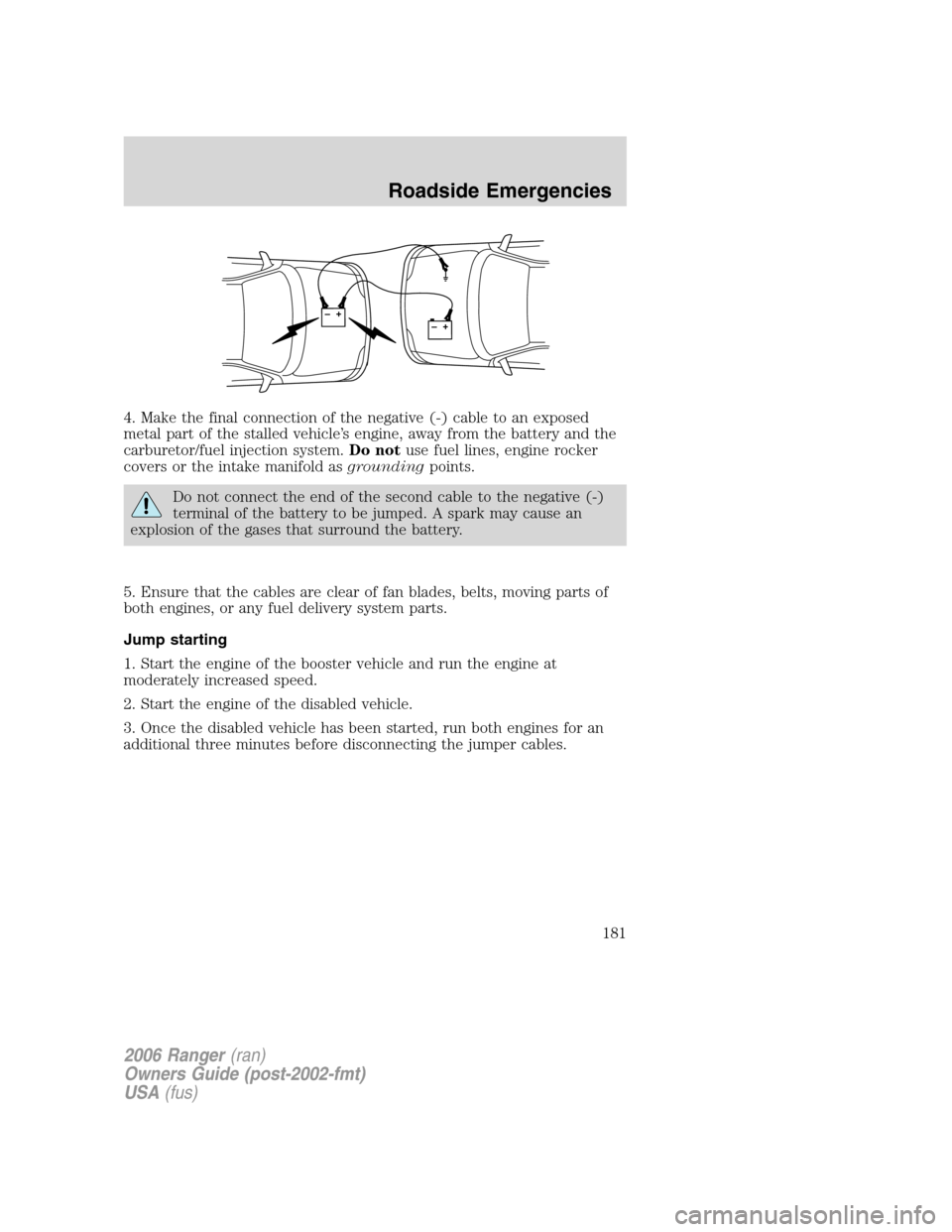
4. Make the final connection of the negative (-) cable to an exposed
metal part of the stalled vehicle’s engine, away from the battery and the
carburetor/fuel injection system.Do notuse fuel lines, engine rocker
covers or the intake manifold asgroundingpoints.
Do not connect the end of the second cable to the negative (-)
terminal of the battery to be jumped. A spark may cause an
explosion of the gases that surround the battery.
5. Ensure that the cables are clear of fan blades, belts, moving parts of
both engines, or any fuel delivery system parts.
Jump starting
1. Start the engine of the booster vehicle and run the engine at
moderately increased speed.
2. Start the engine of the disabled vehicle.
3. Once the disabled vehicle has been started, run both engines for an
additional three minutes before disconnecting the jumper cables.
+–+–
2006 Ranger(ran)
Owners Guide (post-2002-fmt)
USA(fus)
Roadside Emergencies
181
Page 183 of 256
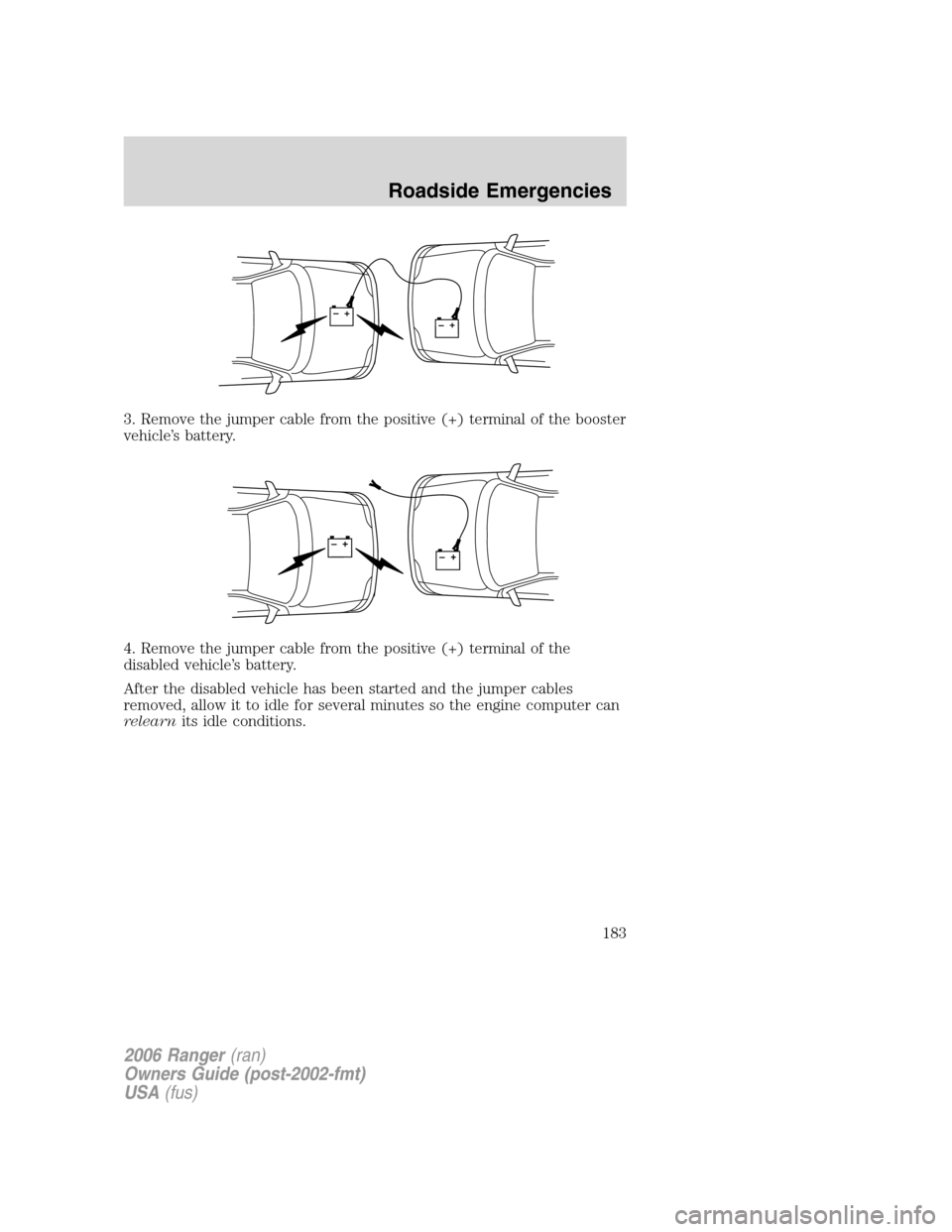
3. Remove the jumper cable from the positive (+) terminal of the booster
vehicle’s battery.
4. Remove the jumper cable from the positive (+) terminal of the
disabled vehicle’s battery.
After the disabled vehicle has been started and the jumper cables
removed, allow it to idle for several minutes so the engine computer can
relearnits idle conditions.
+–+–
+–+–
2006 Ranger(ran)
Owners Guide (post-2002-fmt)
USA(fus)
Roadside Emergencies
183
Page 252 of 256
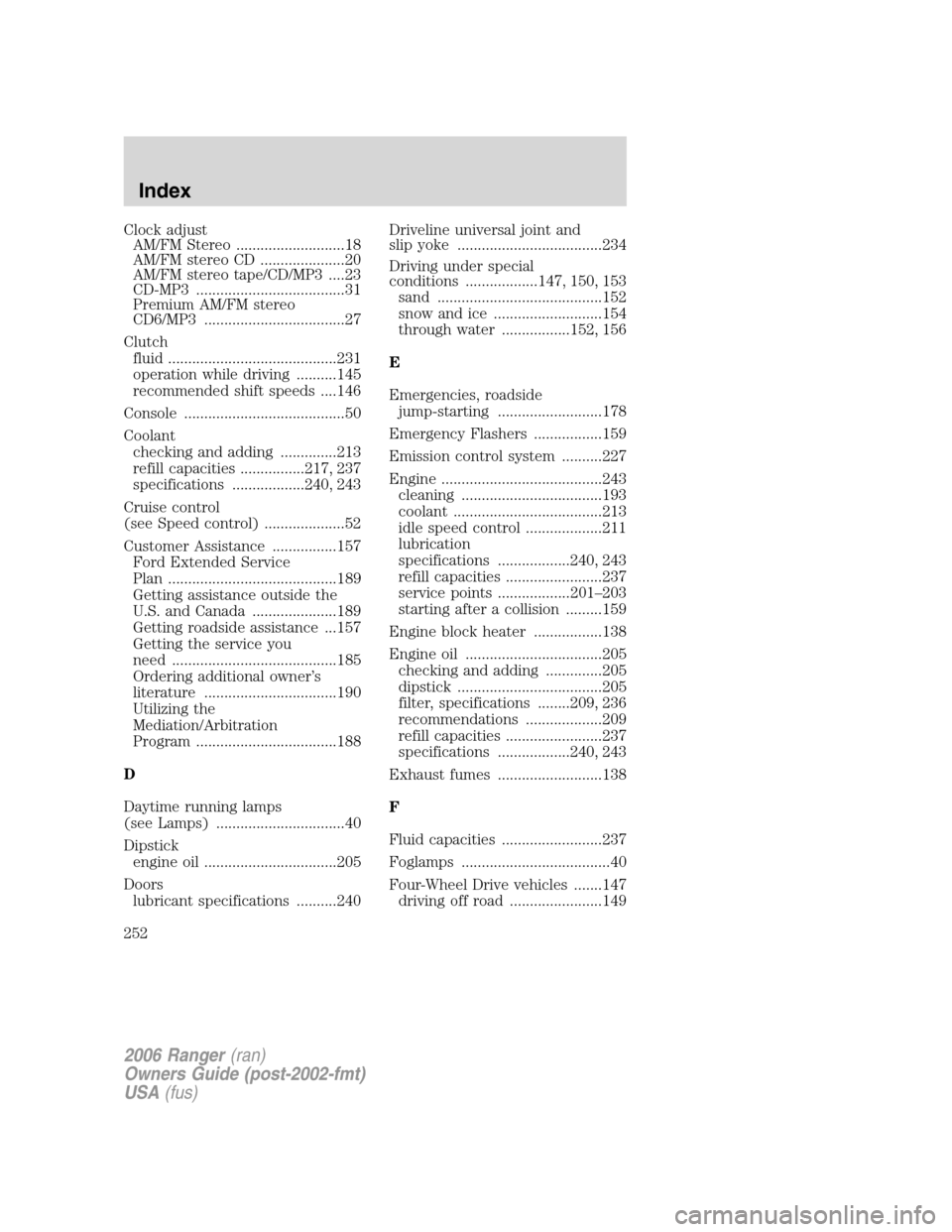
Clock adjust
AM/FM Stereo ...........................18
AM/FM stereo CD .....................20
AM/FM stereo tape/CD/MP3 ....23
CD-MP3 .....................................31
Premium AM/FM stereo
CD6/MP3 ...................................27
Clutch
fluid ..........................................231
operation while driving ..........145
recommended shift speeds ....146
Console ........................................50
Coolant
checking and adding ..............213
refill capacities ................217, 237
specifications ..................240, 243
Cruise control
(see Speed control) ....................52
Customer Assistance ................157
Ford Extended Service
Plan ..........................................189
Getting assistance outside the
U.S. and Canada .....................189
Getting roadside assistance ...157
Getting the service you
need .........................................185
Ordering additional owner’s
literature .................................190
Utilizing the
Mediation/Arbitration
Program ...................................188
D
Daytime running lamps
(see Lamps) ................................40
Dipstick
engine oil .................................205
Doors
lubricant specifications ..........240Driveline universal joint and
slip yoke ....................................234
Driving under special
conditions ..................147, 150, 153
sand .........................................152
snow and ice ...........................154
through water .................152, 156
E
Emergencies, roadside
jump-starting ..........................178
Emergency Flashers .................159
Emission control system ..........227
Engine ........................................243
cleaning ...................................193
coolant .....................................213
idle speed control ...................211
lubrication
specifications ..................240, 243
refill capacities ........................237
service points ..................201–203
starting after a collision .........159
Engine block heater .................138
Engine oil ..................................205
checking and adding ..............205
dipstick ....................................205
filter, specifications ........209, 236
recommendations ...................209
refill capacities ........................237
specifications ..................240, 243
Exhaust fumes ..........................138
F
Fluid capacities .........................237
Foglamps .....................................40
Four-Wheel Drive vehicles .......147
driving off road .......................149
2006 Ranger(ran)
Owners Guide (post-2002-fmt)
USA(fus)
Index
252
Page 253 of 256
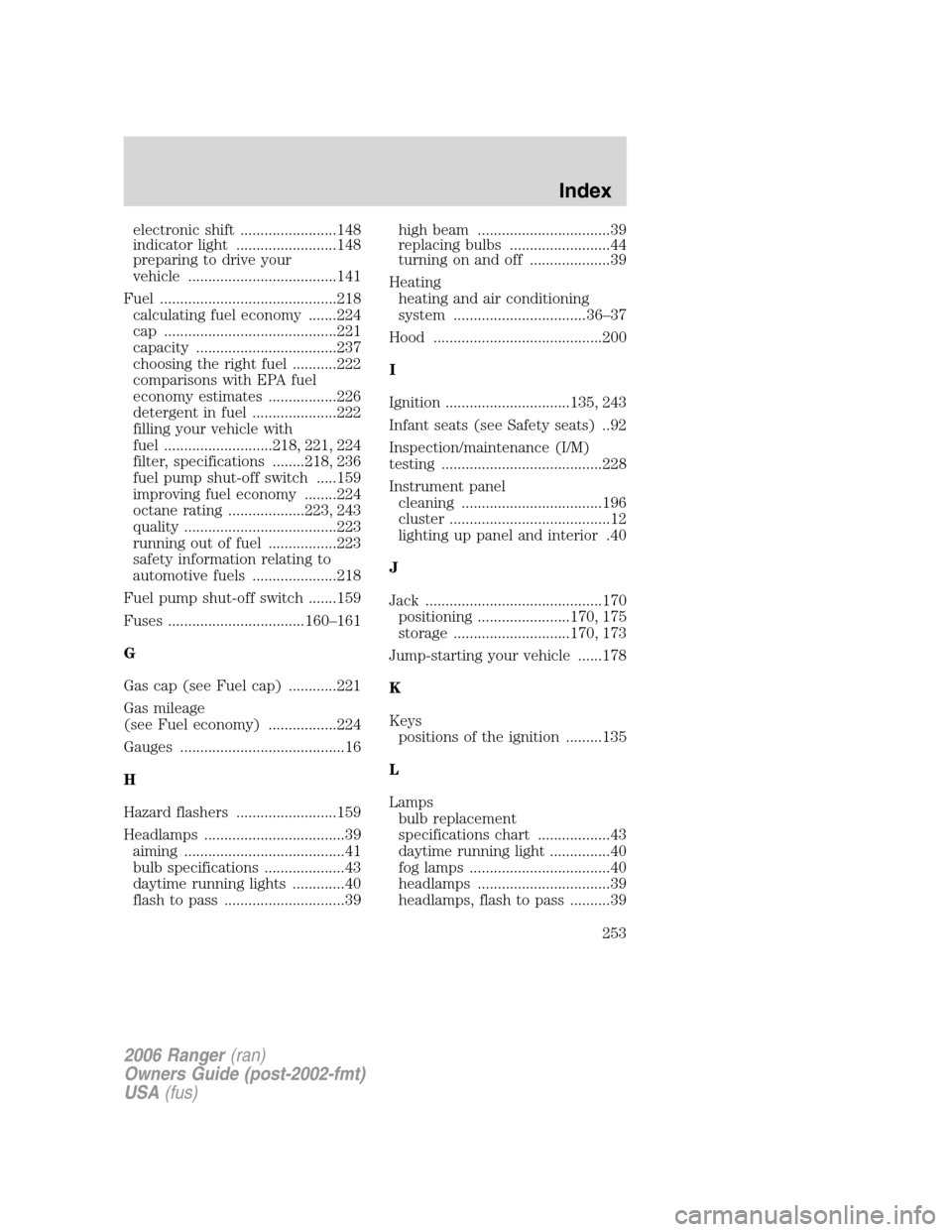
electronic shift ........................148
indicator light .........................148
preparing to drive your
vehicle .....................................141
Fuel ............................................218
calculating fuel economy .......224
cap ...........................................221
capacity ...................................237
choosing the right fuel ...........222
comparisons with EPA fuel
economy estimates .................226
detergent in fuel .....................222
filling your vehicle with
fuel ...........................218, 221, 224
filter, specifications ........218, 236
fuel pump shut-off switch .....159
improving fuel economy ........224
octane rating ...................223, 243
quality ......................................223
running out of fuel .................223
safety information relating to
automotive fuels .....................218
Fuel pump shut-off switch .......159
Fuses ..................................160–161
G
Gas cap (see Fuel cap) ............221
Gas mileage
(see Fuel economy) .................224
Gauges .........................................16
H
Hazard flashers .........................159
Headlamps ...................................39
aiming ........................................41
bulb specifications ....................43
daytime running lights .............40
flash to pass ..............................39high beam .................................39
replacing bulbs .........................44
turning on and off ....................39
Heating
heating and air conditioning
system .................................36–37
Hood ..........................................200
I
Ignition ...............................135, 243
Infant seats (see Safety seats) ..92
Inspection/maintenance (I/M)
testing ........................................228
Instrument panel
cleaning ...................................196
cluster ........................................12
lighting up panel and interior .40
J
Jack ............................................170
positioning .......................170, 175
storage .............................170, 173
Jump-starting your vehicle ......178
K
Keys
positions of the ignition .........135
L
Lamps
bulb replacement
specifications chart ..................43
daytime running light ...............40
fog lamps ...................................40
headlamps .................................39
headlamps, flash to pass ..........39
2006 Ranger(ran)
Owners Guide (post-2002-fmt)
USA(fus)
Index
253